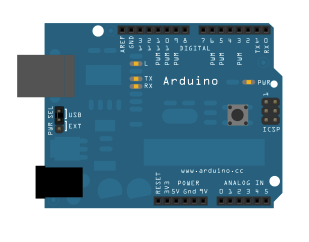Arduino内置教程-字符串-String Comparison Operators
字符串比较运算符
字符串比较运算符==, !=,>, < ,>=, <=,equals() 和 equalsIgnoreCase()函数允许你在字符之间进行字母比较。这个在分类和排序上很有用处。
运算符 == 和 equals()函数是一样的。换句话,
if (stringOne.equals(stringTwo)) {
等同于
if (stringOne ==stringTwo) {
">"(大于)和"<"(小于)运算符根据字母表来在最开始的字符分析字符串。所以,例如,"a" < "b" 和 "1" < "2", 但"999" > "1000" ,因为9跟在1的后面。
注意:当你比较数字字符串时,字符串比较运算符可以会拒绝,因为数字是被看成字符串而不是数字。如果你需要比较数字,把它们作为ints, floats, 或 longs等数据类型比较,而不是作为字符串。
硬件要求
- Arduino or Genuino开发板
电路
- 这个例子不需要连接额外的电路,除了你的开发板需要连接到你的电脑,并且打开Arduino IDE的串口监视器窗口。

图由 Fritzing 软件绘制
样例代码
/*
Comparing Strings
Examples of how to compare strings using the comparison operators
created 27 July 2010
modified 2 Apr 2012
by Tom Igoe
http://www.arduino.cc/en/Tutorial/StringComparisonOperators
This example code is in the public domain.
*/
String stringOne, stringTwo;
void setup() {
// Open serial communications and wait for port to open:
Serial.begin(9600);
while (!Serial) {
; // wait for serial port to connect. Needed for native USB port only
}
stringOne = String("this");
stringTwo = String("that");
// send an intro:
Serial.println("\n\nComparing Strings:");
Serial.println();
}
void loop() {
// two strings equal:
if (stringOne == "this") {
Serial.println("StringOne == \"this\"");
}
// two strings not equal:
if (stringOne != stringTwo) {
Serial.println(stringOne + " =! " + stringTwo);
}
// two strings not equal (case sensitivity matters):
stringOne = "This";
stringTwo = "this";
if (stringOne != stringTwo) {
Serial.println(stringOne + " =! " + stringTwo);
}
// you can also use equals() to see if two strings are the same:
if (stringOne.equals(stringTwo)) {
Serial.println(stringOne + " equals " + stringTwo);
} else {
Serial.println(stringOne + " does not equal " + stringTwo);
}
// or perhaps you want to ignore case:
if (stringOne.equalsIgnoreCase(stringTwo)) {
Serial.println(stringOne + " equals (ignoring case) " + stringTwo);
} else {
Serial.println(stringOne + " does not equal (ignoring case) " + stringTwo);
}
// a numeric string compared to the number it represents:
stringOne = "1";
int numberOne = 1;
if (stringOne.toInt() == numberOne) {
Serial.println(stringOne + " = " + numberOne);
}
// two numeric strings compared:
stringOne = "2";
stringTwo = "1";
if (stringOne >= stringTwo) {
Serial.println(stringOne + " >= " + stringTwo);
}
// comparison operators can be used to compare strings for alphabetic sorting too:
stringOne = String("Brown");
if (stringOne < "Charles") {
Serial.println(stringOne + " < Charles");
}
if (stringOne > "Adams") {
Serial.println(stringOne + " > Adams");
}
if (stringOne <= "Browne") {
Serial.println(stringOne + " <= Browne");
}
if (stringOne >= "Brow") {
Serial.println(stringOne + " >= Brow");
}
// the compareTo() operator also allows you to compare strings
// it evaluates on the first character that's different.
// if the first character of the string you're comparing to
// comes first in alphanumeric order, then compareTo() is greater than 0:
stringOne = "Cucumber";
stringTwo = "Cucuracha";
if (stringOne.compareTo(stringTwo) < 0) {
Serial.println(stringOne + " comes before " + stringTwo);
} else {
Serial.println(stringOne + " comes after " + stringTwo);
}
delay(10000); // because the next part is a loop:
// compareTo() is handy when you've got strings with numbers in them too:
while (true) {
stringOne = "Sensor: ";
stringTwo = "Sensor: ";
stringOne += analogRead(A0);
stringTwo += analogRead(A5);
if (stringOne.compareTo(stringTwo) < 0) {
Serial.println(stringOne + " comes before " + stringTwo);
} else {
Serial.println(stringOne + " comes after " + stringTwo);
}
}
}
更多
- String object – 字符串对象的参考
- CharacterAnalysis - 使用operators来识别对应的特征类型。
- StringAdditionOperator - 用不同方法把字符串加到一起。
- StringAppendOperator - 用+=运算符和concat()方法来添加东西到字符串里。
- StringCaseChanges - 改变字符串的状态。
- StringCharacters - 在字符串里获得或设置一个指定的字符的值
- StringComparisonOperators - 按字母排列顺序地比较字符串
- StringConstructors - 初始化字符串对象
- StringIndexOf - 寻找在字符串里字符的第一个或最后一个的状态
- StringLength - 获得和修剪字符串的长度
- StringLengthTrim - 获得和修剪字符串的长度
- StringReplace - 替换字符串里的个别字符
- StringStartsWithEndsWith - 检查一个给定的字符或子串(substrings)的开始或结尾
- StringSubstring - 在给定的字符串里寻找"phrases"
- StringToInt - 允许你把字符串转换成整数数字
获取最新文章: 扫一扫右上角的二维码加入“创客智造”公众号



















